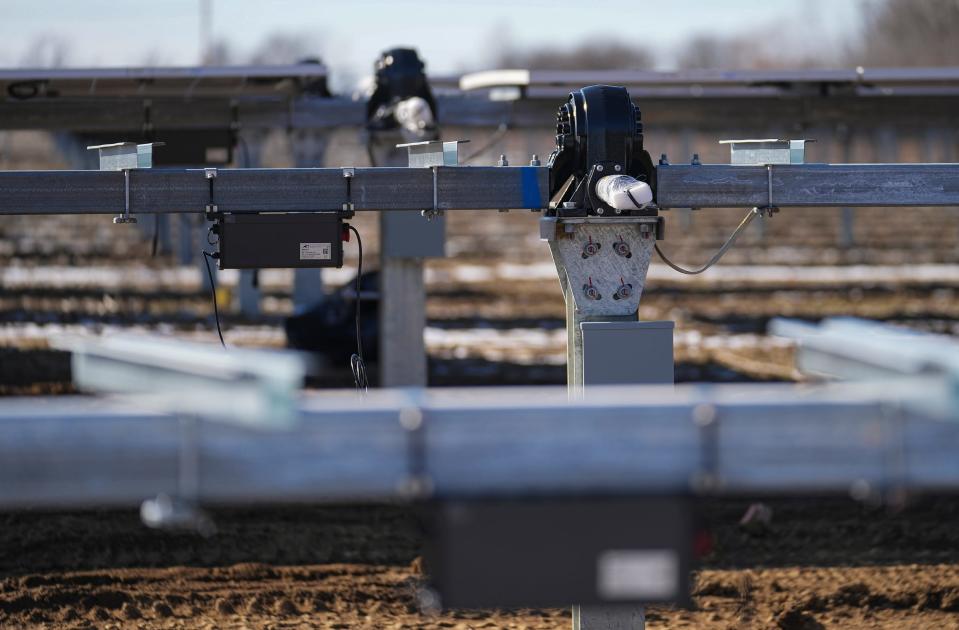Scrub Hub: How do snow and winter weather impact my solar panels? It's complicated.
In Indiana and the Midwest, snow is nothing new. We all know the drill after a snowfall: Roads get plowed, cars windows are scraped, sidewalks get shoveled.
But what about solar panels? What does snow do to them?
Indiana generates nearly 1,500 megawatts of power from solar installations across the state, according to the Solar Energy Industries Association. That’s enough to supply more than 160,000 homes.
A lot of that generation is from the utility-scale side — think massive fields of solar panels like the ones by the Indianapolis International Airport. Still, that total also includes hundreds of Hoosier homes with solar panels on their roofs.
Solar undoubtedly is a growing industry and with that come a lot of questions, especially about whether solar makes sense in colder climates where snow is just part of life.
For this week’s Scrub Hub, we're keeping the renewable topic rolling from the last edition on wind turbines. In this installment, we answer the question: How does winter weather impact solar panels?
For answers, we spoke with an expert from the National Renewable Energy Laboratory and looked at research about winter's affect on solar panels.
Short answer: It’s complicated
The biggest factor that impacts solar panels is the incoming irradiance, or the output of light energy from the sun. In other words, the amount of sunshine hitting panels.
On a sunny day, the input to the average system is about 800 to 1,000 watts per square meter of panel, according to Matthew Muller, a research engineer at the NREL. On cloudy days, that number plummets to 80 to 100 watts — a tenfold drop.
Renewable energy: Solar power is about to become a lot more expensive for Hoosiers as net metering expires
When the sun is out but snow is covering panels, it's another lost opportunity to generate energy. But it doesn’t take much sun to melt off snow, typically a few hours or less, especially if panels are mounted on a tilt.
Many people may think solar panels are best suited for warmer southern climates, but that's not necessarily the case. Efficiency actually falls as temperatures rise. “On a cold, sunny winter day," Muller said, "the solar panel is actually more efficient.” Heat can cut efficiency by up to 15%.
Long answer: Winter impacts are minimal
In the grand scheme for homeowners, energy lost from snow is minimal over the course of a year, Muller said. Summer definitely is when the most energy is produced.
That said, there are other factors that impact the efficiency of solar systems and technology advances to maximize output.
Have you ever driven by a big solar array and panels appear to be in a different position? You’re not seeing things. Many systems move to follow the sun. That positions panels to continuously capture the most energy. Tracking isn’t available for most rooftop installations, but works for utility-scale systems.

Bifacial panels, which capture sunlight on both sides, are also being used in solar installations. The top still produces the most energy, but the bottom can bring in extra power from light reflecting off the ground — especially when its covered with snow.
“Think when you’re outside on a sunny day when there is snow on the ground and you want sunglasses because the glare is so bright,” Muller said.
The two-sided panels, designed for large systems rather than rooftops, can add about 10% of what the top panel alone generates.
Rooftop solar: How many solar panels do I need? Does solar really save me money? Your questions answered
Another thing that can decrease efficiency is "soiling," when panels get dirty. This is more of a factor in arid or dusty areas such as the southwest. Grime can cut efficiency by as much as 20%.
While not as much of an issue in the Midwest, some areas on the East Coast have problems with pollen and mold covering panels. Muller is researching that topic to learn more about the broader impacts.

On the other hand, rain and snow provide free cleaning that helps restore efficiency.
Homeowners considering solar should always ask prospective providers how efficiently their panels can be expected to perform in various conditions.
If you have more questions about solar panels, renewable energy or any other topics, let us know! You can ask us by submitting a question through our Google form below. Can’t see the form? Click here.
Call IndyStar reporter Sarah Bowman at 317-444-6129 or email at sarah.bowman@indystar.com. Follow her on Twitter and Facebook: @IndyStarSarah. Connect with IndyStar’s environmental reporters: Join The Scrub on Facebook.
IndyStar's environmental reporting project is made possible through the generous support of the nonprofit Nina Mason Pulliam Charitable Trust.
This article originally appeared on Indianapolis Star: Solar power in Indiana: How do panels work in snow, cold weather?

